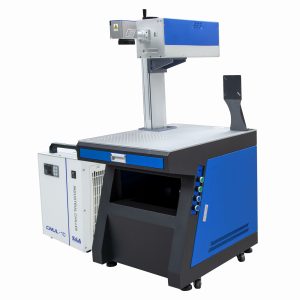Infrared Picosecond Marking Machine
What is an Infrared Picosecond Marking Machine?
A laser marking device that uses infrared lasers with picosecond pulse duration is known as an infrared picosecond marking machine. These lasers create incredibly brief and quick bursts of light because the term “picosecond” refers to 1012 seconds. Picosecond lasers can produce cleaner, higher contrast markings by interacting with materials more finely and accurately due to their brief pulse duration. This decreases the heat-affected zone.
How it works?
Laser Source: The picosecond laser itself serves as the brain of the marking device. These lasers produce powerful, brief pulses of light. The laser-material interaction period is limited due to the highly brief pulse duration, which lessens the thermal impacts on the material.
After the laser source, a number of mirrors and optics direct and focus the laser beam onto the target material. This process is known as beam steering. These are frequently managed by galvanometer scanners, which can quickly change the beam’s position for rapid engraving or labeling.
Focusing: A lens system concentrates the laser beam to a pinpoint spot on the surface of the material. Accurate and low-impact marking is guaranteed by the focus’s accuracy and the brief pulse duration.
Picosecond laser pulses can evaporate, vaporize, or cause other changes in the target material when they come into contact with it. Without significantly heating the surrounding area, this causes permanent markings.
Application: Where is it used for?
Due to its accuracy and low thermal impact, infrared picosecond marking machines have a wide range of applications. Among the applications are:
Microelectronics: Precision and low thermal impact are essential when engraving or marking small, sensitive components.
Medical Devices: Engraving of surgical implants, medical instruments, and other items that require sterilization and traceability.
Precision engraving and precise design detailing in jewelry and watchmaking.
Automotive: Traceability marking for parts, particularly for high-performance parts where less structural influence is preferred.
Aerospace: For marking parts for traceability and assuring the component integrity, similar to automotive.
Research and development: Any field that requires tiny surface alteration or precision marking.
Conclusion:
The Infrared Picosecond Marking Machine, which provides unmatched precision and no thermal impact, is proof of the developments in laser technology. These devices may interact with materials in ways that were previously difficult, if not impossible, with conventional lasers by harnessing the power of highly brief laser pulses. Tools like the Infrared Picosecond Marking Machine become increasingly important as businesses move toward downsizing, better precision, and a requirement for higher quality. This technique promises to meet and surpass the needs of contemporary production and design, from the fine details of jewelry design to the rigorous standards of aerospace and microelectronics. One may predict its continuing evolution, which will increase its scope of uses and effectiveness, as with many technological advancements.
Showing the single result

 HOME
HOME
 GET A QUOTE
GET A QUOTE  QUOTE BASKET
QUOTE BASKET 


